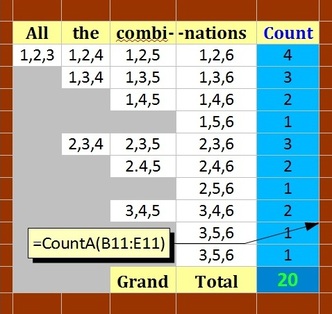 "Choose Three of Six" : Image by Mike DeHaan
Canadian Content and Publicity for my Lottery Calculation Articles
One Low-Risk Writing Tip
Today's writing tip is similar to one I've offered before.
Start with a specific topic. In this case, my Decoded Science editor commissioned an article about the currently wildly popular Powerball.
Then look at the big picture. First I researched the specific calculation for any lottery, as well as the necessary rules for Powerball. Then I realized that Canadians have a similar lottery, although the rules and therefore the probabilities of winning are slightly different.
Writing for DeHaan Services allowed me to promote my Decoded Science article as well as to address the Canadian market separately.
That allowed me to publicize my DeHaan Services article to a Canadian-only site. That also provides an indirect marketing play for Decoded Science.
Whether you're writing about the odds of winning a lottery or how to buy a new computer, it's often useful to change focus in order to address the needs of a new audience of readers.
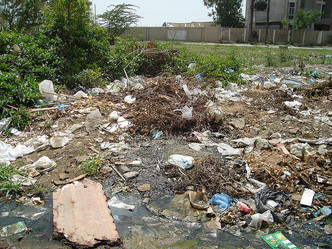 "Plastic Bag Nightmare" image by Zainub (Zainub Razvi) My recent " Does Toronto Stand Alone in Banning Plastic Bags?" is a public service announcement from DeHaan Services. Normally I write about Toronto events there, but I just had to share an infographic that was contributed. Their group does a lot of research and makes great images to share their information.
Publicizing my Plastic Bag Article
One Long-Lasting Writing Tip
Today's writing tip comes from analyzing my contributor's actions.
They want to maximize the number of readers for their material. They include a link to their site; that link actually passes the infographic forward to my article.
Therefore their site gets credit for page views when my page is loaded; at least that's what I think is happening.
In addition, their infogrphic shows their contact information. Anyone looking for them can easily trace them; which means more page-views and perhaps more interactions with interested readers.
In return, of course, I get some fresh and interesting content for my site.
So if you want to increase your online visibility, consider contributing some good material to someone you trust to give you the credit for the research and writing.
If you actively solicit content from others, you should be prepared for the question "Do you pay for my work"?
If someone volunteers material for you to share, and if it meets your standards for quality and topic, then it's almost certainly a good idea to make use of it.
Your regular readers might appreciate the break; their regular readers might find you; and it's possible for the search engines to like both of you better.
Even an unpleasant topic like pollution due to one-use plastic shopping bags might offer long-lasting benefits.
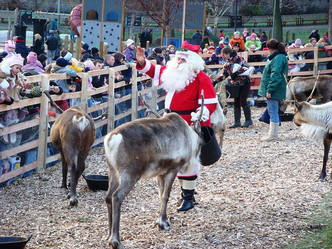 "Santa Claus at Edinburgh Reindeer Garden" image by www.theedinburghblog.co.uk My latest DeHaan Services article, " Three Outdoor Carol Events in Dec. 2012 in Eastern Toronto", was written because I was surprised to see three similar upcoming events, at different venues and organized separately (so far as I knew). In fact, I might not have noticed any of them except that something else had caught my attention on that page in a local newspaper.
Promoting my "2012 Toronto Caroling Outdoors" Article
One Wintry Triple Writing Tip
This writing tip repeats some old but golden ideas. Traditionally we think of past and future for the winter solstice, since January is named for the Roman god Janus, whose double face looked forwards and backwards.
First, keep your eyes and mind open to writing possibilities. I only noticed the first event because an e-mail address that I needed was on the same page, attached to some completely different item. Then I scanned the other notices, and found the first Christmas caroling event.
Second, think about what makes a topic unique or special. In this case, "outdoors" was the magic word. Personally I find myself singing carols indoors. Going outside would be different for me; and I tried to make it interesting for others too.
Third, look for patterns. After finding the first, I quickly noticed the second. In fact, my title and promotional blurb used words like "two", "double" and "twin. After a more careful review of the upcoming events, I realized that there was a third outdoor carol singing event.
That's my triple writing tip for this wintry night: be alert for new or simply intereting topics; then seek out the novelty of one unique topic or an interesting common thread among multiple examples of a topic idea.
 "German Bible and English Bible" image by inkknife_2000 (Don Graham) In my haste to get a lot of work done, I'd neglected to publicize two of my recent Suite 101 articles about Mennonites. " Distinctly Mennonite Beliefs in the 1995 Confession of Faith" reports on the most recent statement of modern Mennonite beliefs which was adopted by many North American Mennonites. This is filed under the "Mennonite Beliefs" channel in Suite 101. " The Death of the Mennonite Martyr, Dirk Willemsz" is part of the "Mennonite History" channel. Willemsz is famous for saving the life of his pursuer; this act of kindness doomed Willemsz but ensured his place in Mennonite history.
Publicity for Two Mennonite Articles
Twin Writing Tips from Two Mennonite Articles
Let's start with a writing tip about the efficiency of working with similar themes. When writing the Suite 101 articles, there was not a great deal of synergy between the two topics. One was about a long-dead martyr; the other about a new statement of beliefs. There was little background for Willemsz beyond the main reason for his fame. I had to dig fairly deeply to find something that was new to me.On the other hand, the whole 1995 Mennonite Confession was available so I had more material than could fit into Suite 101's usual format. I did find it helpful to write one publicity article for both. In the one DeHaan Services blog post, I discuss briefly whether Willemsz would be willing to die for the new Mennonite beliefs. My second writing tip for today is a reminder to remain up-to-date with your publicity. I had covered most of the bases, but had put my focus on a third Suite 101 article written at about the same time. " Did the 'Canadian Mennonite' Become Political in 2012?" was my hot topic and so it received publicity from my blogs. Although all three were bookmarked online, these two had not received their full due. Whether the topic is Mennonite beliefs from 1995 or a Mennonite martyr from 1569, new articles deserve to be publicized in a timely fashion.
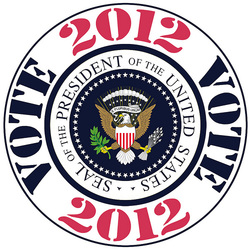 "Vote in the 2012 Presidential Election" image by DonkeyHotey My latest Decoded Science article, " A Statistical Method for 2012 Election Vote Fraud Allegations", provides one pro forma approach to a statistical method for the analysis of an hypothesis or allegation. In this case, we reviewed the "108% voter registration in Wood County, Ohio" allegation that implied that Obama won the Wood County election thanks to the 8% more people registered to vote than voting-age people who lived in Wood County according to the 2010 census. My article shows how one could use the 2012 opinion polls to determine whether to accept or reject the hypothesis that over 8000 excess votes were cast for Obama in Wood County.
Promoting my 108% Voter Fraud Article
One Democratic Writing Tip taken from "108% Registration Fraud"
This should be a short writing tip with a sharp focus, because the tip is to "focus sharply". When I began researching this article, I saw a double allegation. First was that the 108% voter registration was fraudulent. The second allegation was that the extra 8,000+ registrations led to Obama's victory in Wood County, Ohio. One might write a short book to cover that pair of topics, but Decoded Science prefers to finish within about 1,000 words. Therefore I decided to avoid deciding whether the 108% registration was an unusual event, or consistent with previous elections. As well, any discussion of the legal processes of the US Census, or Ohio voter registration, were explicitly put aside rather than explored. Instead, I crafted one "hypothesis" about the actual versus expected election result in Wood County for 2012. That became the sharp focus of my article. Both statisticians and writers benefit from clear and concise statements. Incidentally and slightly off the topic of this writing tip, I re-used some of my calculations from my recent post-election article in Decoded Science, " Reliable Pollster Report Card in 2012 Presidential Election". If I hadn't already crunched numbers from opinion polls, I might have reported on other numbers: census, versus voter registration, versus total votes cast, versus margin of victory. The method would be extremely similar, but since I already had reviewed some data, I made use of it. This also saved some room in the "108% Fraud" article, since the "Pollster Report Card" had determined values such as the standard deviation which I needed for the recent article.
 "Old School Vintage Road Bicycle" image by Ha-Wee (Howie Le) My latest article in DeHaan Fitness... doesn't "fit in" well, since it's less about exercise or diet, and more about safety in public spaces. " Will Losing Jarvis Bike Lanes Hurt Bicycle Safety in Toronto?" was written because, in Toronto, Jarvis Street just lost its briefly-acquired dedicated bicycle lanes. Cycling advocates had touted the safety factor in separating bicycles from automobiles. There was a rather odd political comment when the bike lanes were removed, although the usual argument is that the extra car lane improved the flow of traffic.
Publicity for my Bike Safety versus Fitness Article
A Writing Tip from Bike Safety versus Fitness
Perhaps this is less a "writing tip" than a moment of introspection.
I've been writing about annual Toronto events, such as marathon races or "Taste of the [street]" festivals, in DeHaan Services. Diet and fitness are the staples for DeHaan Fitness, although it has far fewer articles.
Although the change to Jarvis Street might affect cyclists' fitness by making them go slower for safety, or by giving them reason to stop bicycling to work, one serious concern is the political tone that came at the close of the debate.
By the way, the "political tone" is the reason that this blog entry title includes the odd phrase, "automobile citizens". Read my main article to learn why!
I wanted to make a note of that, but do not have a suitable forum.
Time will tell what kind of reaction, if any, this article receives. It's not well focussed on fitness, that blog's main subject. It would not have fit with Toronto events in DeHaan Services.
The writing tip is that you sometimes need to consider, and then decide, whether and where to publish your thoughts. Stay true to yourself and your ideals, but also remain consistent to the brand of your platform, whether it is a blog, magazine or newscast. For this article in DeHaan Fitness, I'm not sure that I kept my feet on the tightrope.
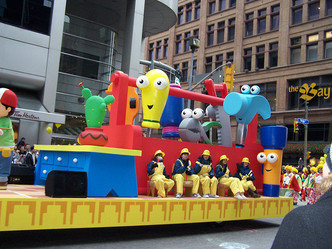 "2009 Santa Claus Parade in Toronto" image by c'est la Viva
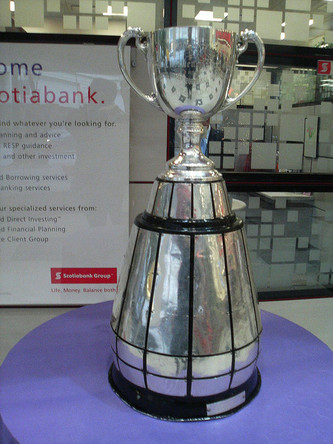 "The CFL Grey Cup in 2006" image by roland (Roland Tanglao) The Canadian Football League's 2012 Grey Cup championship game will be played in Toronto.
By lucky coincidence, the annual Toronto Santa Claus Parade weekend coincides with the start of the 2012 Grey Cup Festival. At least some Toronto Argonaut cheerleaders, and probably some CFL alumni, will join the Santa Claus parade.
So both articles link to the other. You could get a touch of football at the Santa Claus parade, and you'd need to avoid the parade route if you want to get to some of the other 2012 Grey Cup Festival events.
Promoting my Santa Claus Parade and Grey Cup 2012 Events Articles
A Double Writing Tip for Paired Events
Here is a double writing tip, but it has a bit of background first. Both the annual Santa Claus Parade in Toronto, and the annual Grey Cup which is hosted by different Canadian cities, deserve some publicity. Let's admit that both can budget for advertising. Normally I do not publicize professional sports. The fans can buy tickets elsewhere, and they would expect expert commentary in a blog. Those who don't care for the sport won't read my article about that event. However, in my opinion, the Grey Cup Festival organizers did not promote the events nearly well enough for me to notice. As well, they do offer quite a packed program of free activities. That's precisely the DeHaan Services niche for articles about Toronto events: free or cheap, under-publicized, and interesting. Then, these two events overlap on the calendar and nearly collide in downtown Toronto. I wanted to write about both; and I also had another article, " Reliable Pollster Report Card in 2012 Presidential Election", to write and publicize at the same time. My first writing tip is that, when you write about conflicting events, or even about coincidences of any kind, is to note and admit the overlap in both articles. In fact, that could become the main message for at least one article. (That's not how I handled the 2012 Grey Cup "versus" the Santa Claus Parade in Toronto. However, I could have written about the scheduling conflict). The second writing tip then deals with publicity for yourself. Go beyond a mere mention of the other topic; provide the article's title and link to it if it's online. That's the approach I took in writing about both the annual Santa Claus Parade and the Grey Cup 2012 Festival in Toronto.
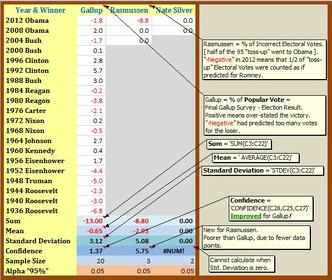 "Gallup Rasmussen and Silver Poll Reliability 2012" image by Mike DeHaan
Promoting my Pollster Report Card
One Writing Tip for Repeating Report Cards
I've mentioned the idea for this writing tip before, but it bears repeating.
It's about repeating a topic.
A better phrase would be to re-visit a topic.
Earlier in 2012, as the USA's presidential election race was heating up, some people began questioning the validity of several opinion polls.
That gave me the opportunity to suggest a way to determine what voices should be heard. Check the track record of different polling organizations, and give the most weight to those with the best statistical record.
My article looked at results up through the 2008 election in the USA.
Clearly that invites a follow-up article to determine how well they did in the election in 2012.
Keep this writing tip in mind: if the first article is worth writing, can it be worthy of a re-visit?
I certainly thought that the statistics to grade pollsters was a pleasant topic the second time around.
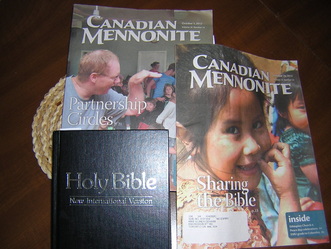 "Bible and Canadian Mennonite Magazines" image by Mike DeHaan
Further Publicity...
One Mennonite Writing Tip
My writing tip remind "all us writers" to remain aware of current events; and to maintain some journalistic detachment from the problem.
When I first learned about this contretemps between a government agency and the Canadian Mennonite magazine, my first reaction was a mild concern about this issue. It affects my denomination and people in it.
As a writer, I'm ashamed that it took me a day or so to realized that I was sitting on a current events article.
For goodness sake, don't let journalism turn you into an unfeeling vampire, leaching news from people who need assistance or compassion.
But once you've applied first aid, write about the situation.
Although I can't do much about the problem for my denomination's publication, I certainly can and should write my article based on current events encountered by the 'Canadian Mennonite' magazine.
 "One Diwali Candle for the Festival of Lights" image by denharsh (Harsh Agrawal) Based on the Hindu lunar calendar, the date for Diwali floats through October, November and December in the western Gregorian calendar. Therefore "when is Diwali?" is a remarkably popular search item.But to answer that question in DeHaan Services, I had to include a "Toronto angle" in " Must Toronto Ask When is Diwali in 2012?".
Promoting my Diwali Article My Writing Tip for Diwali
Actually, this writing tip can be appropriate at any time.
Because I was so surprised that the world asks "when is Diwali?", I did some quick research to check on other religious observances that depend on various lunar calendars.
By putting just a touch of that research into my article about Diwali, readers can learn a bit about different cultures and religions. More importantly, this demonstrates that many groups have similar challenges in maintaining their cultural or religious heritage.
From a purely selfish standpoint, it may attract a few more readers, if anyone searches for "Jainism", "Judaism" and "Easter" (for example) in one query!
|












 RSS Feed
RSS Feed